|

|
- Picking
Pearl Projects
-
- There's no "perfect" pearl and no
"perfect" project. Each student is unique.
Each class is unique. Each teacher is
unique. Explore the
following two projects. They provide good
examples of engaging, technology-rich
projects.
-
|
Pearls are rated by their quality. You can do the same
thing with classroom projects. However, remember that
different people have varied needs and interests. What
might work in one classroom might be ineffective with
another teacher and set of students.
-
- When judging a pearl, there are seven categories
that should be considered. If you're interested in
"real pearls", check out the Black
Pearl site.
-
- Let's explore these categories within the context
of engaging classroom projects. Explore each of the
following areas to learn more about picking a pearl
project that's best for you and your students.
|

Size
|
-
Pick a pearl that's the right size for
you.
- One shot project
- Large project
- Ongoing project
- One Shot Project
- A "one shot project" can be completed
in a relatively short period of time. They
can take a day or a month depending on the
task and product. These projects focus on
a specific outcome and are limited in
scope. For example, students might post
oral histories or photograph an eclipse.
Think about what students could share or
teach someone.
-
- When considering a project, ask
yourself: Is there enough depth? Is it
meaningful?
-
- The sign
language student project is just the
right size for a group of students. It
contains digital pictures and short
animations. The content includes basics
and practice.
-
- Large Project
- A "large project" may take place over
a longer period of time and include a
number of different outcomes. For example,
students might build a virtual museum or
develop a community project. You might
coordinate a reading project or draw many
schools together for an activity.
-
- When considering a project, ask
yourself: Do you have a realistic
timeline? Is it worth the energy?
-
- The Queen
Street student project involved the
class in learning more about their
community. After drawing pictures,
creating digital pictures, and gathering
information, they created a web project
about their community.
-
- Ongoing Project
- An "ongoing project" involves students
on a regular basis over a long period of
time. Although the activities may be short
or long, the emphasis is on students
becoming continuously involved in an
evolving project. For example, students
might explore a project where they look at
"this day in history" each day or see a
science experiment blossom over many
weeks. They could watch an online database
grow as each participant adds their
information.
-
- When considering a project, ask
yourself: Can you maintain interest?
-
- The TESAN
project asks students around the world to
learn more about the natural areas near
where they live. Participants from around
the world add their projects and students
can see their website evolve.
-
- Size - Choose It
- When choosing the size of your
project, ask yourself: what's the best
project size for me? Remember to start
small and be realistic. Focus on a core
concept rather than an entire unit or
subject area. Also consider joining with
others for a larger impact.
|
|

Shape
|
-
- Pick the pearl that fits your needs.
Pearls can be round, drops, ringed, and
buttons. Explore the different types of
information that can be shared. What will
work best with your students, your
teaching style, and your content?
- Text
- Sound
- Still & Motion Visuals
- Real Objects
- Text
- Word processing, writing software,
HyperStudio, and web pages can all be ways
that students can share their ideas
through a text-based format. They can
explore the writing process and express
their ideas.
-
- CyberStories
is a ThinkQuest project that posts student
writing projects. Students can also
incorporate pictures into their
projects.
-
- Sound
- The auditory channel is often
overlooked in classroom activities.
However poetry and oral history projects
benefit from the use of audio recordings.
You can hear the emotion in a poem or a
story when it's spoken aloud. Also
consider projects that involve musical
instruments and nature sounds.
|
Ask students to create a
HyperStudio stack and narrate it
themselves.
The example on the right is a
HyperStudio stack on Spanish
language and animal sounds.
|
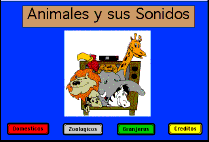
|
- Still Images
- A picture is worth a thousand words.
The picture could be from a digital
camera, scanner, clip art CD, or a
graphics packages. Beginners might use
KidPix and more advanced students
PhotoShop, however any graphics package
can be used for students to express their
ideas visually.
-
|
Although students can find
lots of clip art, it's sometimes
fun to just use the paint tools.
In the example on the right,
paint tools are used to draw
pictures of different
habitats.
|
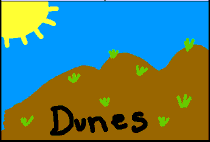
|
- Some students use diagrams or concept
maps to show ideas. For example, students
developed a project on AIDS
and used an image map for their main menu.
Another group working on a different
AIDS
project scanned hand-drawn pictures.
Photographs are also a great way to
express ideas. The Alaskan
Wildflower project uses lots of
photographs.
-
- Moving Images
- Moving images are a good means to
express ideas visually. They can show
steps in a process or movement of an
object. Moving objects can include movies,
videos, QuickTime movies and VRs, and
animation.
|
The HyperStudio project on the
right incorporates a QuickTime
movie.
|
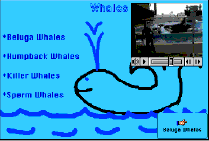
|
- Real Objects
- Real-world objects are an important
part of learning. Students can share their
ideas through science experiments or field
trips. Travel buddy projects involve
sharing thingss such as books, stuffed
animals, or science objects over long
distances. Students can record their real
objects by using audio recordings,
digitized pictures or other graphics.
-
|
The project on the right takes
students step-by-step through a
science experiment.
|
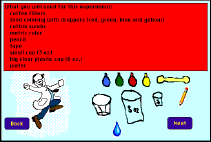
|
- Shape - Choose It
- When choosing the shape of your
project, ask yourself: what technology
fits my project needs? Think
"communicate", not hardware and software.
Start small and add to the project. Rather
than trying to use all the technologies,
focus on just a couple for a particular
project. Give students choices and options
to fit their individual interests, needs,
and skills.
|
|

Surface
|
-
- Pick an authentic pearl, but remember
there are no "flawless" projects. It's
better to have a real pearl with flaws
than a clearly plastic pearl.
- Real-world
- Simulated
- Contrived
- Fakey
- Real-world
- Students created a ThinkQuest project
on the topics of birds.
This project involved students in drawing,
writing, observing, recording, and sharing
information about birds they've seen in
their school yard or at home. This is a
great example of bringing the "real-world"
into the classroom.
-
- Simulated, Contrived,
Fakey...
- Have you ever read the book "The
Lorax"? It's a great way to teach students
about the environment. There's a website
where you can play a Lorax
game. The game is fun and goes with
the book, but wouldn't planting a "real
seed" be more effective than playing a
game about seeds?
-
- Surface - Choose It
- When choosing the surface of your
project, ask yourself: how authentic is my
project? Students should have a real
audience for their project. They need to
focus on meaningful objectives. The
situation or activity should involve real
people, places, and things. The resources
and data should be collected and analyzed
by the students. The results should be
shared and have an impact. Does your
project contain these elements?
|
|

Luster
|
-
- Pick an attractive pearl and pick a
motivating project. The activities should
be exciting, stimulating, and fun! High
impact activities involve students in
exploring information and connecting the
past, present, and future.
-
|
In the project on the right,
students learned about a real
ship that sank many years ago.
They used the Internet to learn
about why it sank and how today
people are locating treasure from
the ship.
|
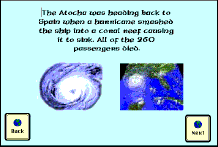
|
- Luster - Choose It
- When choosing the luster of your
project, ask yourself: how motivating is
the project? Does it draw the attention of
my students? Does it maintain interest?
Are students accessing or generating
interesting and useful information? Are
they using exciting technology tools? Does
the project produce interesting and useful
results?
|
|

Orient
|
-
- Pick a pearl that works alone and as a
set. When considering a collaborative
activity, think about the role of the
individual and the group. Think about how
you might reach outside your classroom to
connect with other teachers, students, or
experts.
-
- Collaboration
- Be realistic when planning
collaborative projects. Carefully group
students. Think about how students in
different areas or countries might be
involved. When joining a global project,
consider the needs of students and
teachers in both locations.
A teacher in Indiana teamed with a
teacher in the Netherlands to produce a
fun project that involved collaborative
writing and drawing. Check out their
monster
project.
-
- Orient - Choose It
- When choosing the orient of your
project, ask yourself: how will people
work together? Remember that a
collaborative project involves planning
for both the individual and the group.
Organize team building activities to
promote group spirit, but also develop
individual guidelines and checklists to be
sure that each student is working and is
part of the team.
|
|

Tone
|
-
- Pick a pearl to match the spectrum of
personalities in your class. Think about
individual interests, learning styles, and
high level thinking.
-
- When developing activities, think
about varied:
-
- channels of communication
- reading levels
- speeds
- products
- sharing
- When developing assessment, think
about varied ways to address:
-
- core concepts
- thinking skills
-
- Explore a Track
and Field project developed by some
middle school students. When thinking
about the multiple intelligences of
learners, this project would be
particularly good for students who were
strong in the visual area because of all
the photographs. It would also be good for
students who need lots of movement in a
project.
-
- Tone - Choose It
- When choosing the tone of your
project, ask yourself: how does this
project meet individual needs? Have you
considered alternative activities and
assessments?
|
- Pearl Categories
-
- When developing a project, think about whether
you're interested in a natural, cultured, or imitation
pearl.
-
- Natural Pearls are born in the "real
world"
- Cultured Pearls are carefully planned to
look like the "real world"
- Imitation Pearls are made of glass or
wax.
- Imitation Pearl Project
- Use CD-ROM and Internet to find
information about landforms.
- Create a HyperStudio card for your
landform.
- Create a class "science field
trip"
|
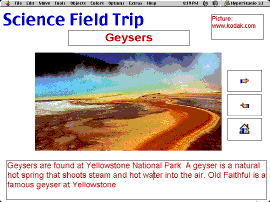
|
- Cultured Pearl
- Explore national
parks online
- Select a park with an interesting
landform.
- Learn more about the landform.
- Use MapQuest
to plan a trip.
- Create and connect the student
webpages.
|
|
- Natural Pearl
- Study the geology in your area.
- Contact an expert.
- Explore related issues.
- Share your project online.
- Compare landforms around the
world.
- Explore this project by some students
in Hawaii.
|
|

Dive for
Pearls
|
- Real or
Fake?
-
- Your Mission:
Turn an imitation into a real pearl
project!
|
  
|